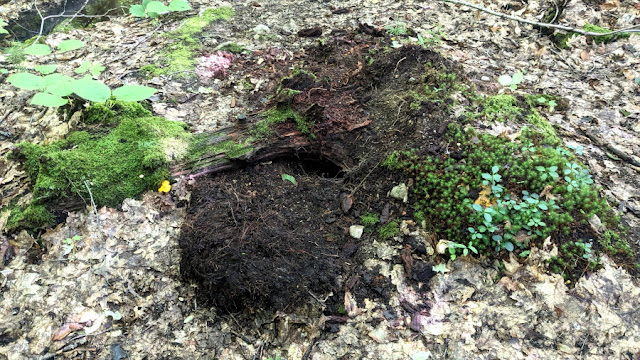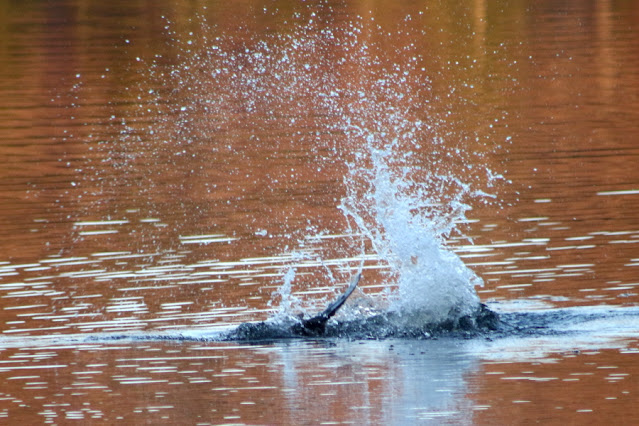I hadn't been to the newly conserved Moultonborough Falls Conservation Area which protected 3000 feet of shoreline along the Red Hill River and Lees Pond in Moultonborough. So this week, accompanied by a good friend, we took a walk to explore the area. (Thanks MM!) We found a freshly cut trail that runs up over a hill then down to the Red Hill River where it crosses under Route 25 after leaving Garland Pond. The trail follows the river down to Lees Pond, and then along the northern edge of the Pond. That's where we found the bear evidence.
 |
| Bears up high. |
The scars in the bark of this American Beech went all the way up the trunk as far as we could see. The foliage was pretty dense so we couldn't see if there were any signs of a bear having built a nest up in the canopy where it might nap in between munching on the beechnuts that will soon be ripening. I try to remember to look for claw marks on large beech trees, as it's always a fun find in the woods, as well as a reminder that we share the forest with others, especially in riparian areas with lots of water and diverse habitats.
 |
| Red Hill River downstream from Garland Pond. |
On another excursion, this time behind Lake Wicwas in the Hamlin Conservation Area, I came across another sign of bear activity, this one down below ground level.
 |
| Bears down low. |
Here a bear had dug down underneath an old rotten log right beside the trail, most likely in search of a nest of carpenter ants full of high-protein ants, larvae, and eggs. You can find this along the Blue Trail north of the beaver ponds, about half way to where it ends at the Yellow Trail heading up to Crockett's Ledge. It's (mostly) comforting to know that we have only black bears in New England, which are skittish and almost always run from human activity. The rare exception being when they have become acclimated to humans due to being fed either intentionally or unintentionally, usually from bird feeders or poorly managed trash. Then it often means the bear must be killed.
Next was an example of the other end of the food chain, where ants are the consumer.
 |
| A rosy maple moth being devoured by other insects. |
It was the rosy maple moth on this fern that caught my eye, but when I looked closely I saw the other insects on it and I realized the moth was dead. The ants were all over the tail, and there was a scorpionfly on it as well, though the the scorpionfly moved away when I approached.
 |
| Scorpionfly |
Scorpionflies look menacing, but that isn't a stinger on its tail; it's a clasper used in mating.
Nor is that beak used for biting. Scorpionflies scavenge on dead insects just as it was doing here, sharing the moth with the ants.
I don't know if the bears are going to be treated to a good beechnut crop this fall, but it sure looks like there will be plenty of pine cones for the squirrels and the birds. If you spend any time glancing up at the tops of trees you've probably noticed the great clumps of white pine cones hanging up there like bunches of bananas. When they ripen they'll provide a feast for the forest animals, and hopefully some that will regenerate forests with new pine trees in open areas. At least those that don't get torn off by all these thunderstorms before they can mature.
 |
| There are plenty more still up in the tree tops - it's a good year for white pine. |
The weekly status on the loons hasn't changed, other than LuLu and Checkers are looking more grown up every day.
Though I have looked, I still can't find evidence of the second pair of loons on the lake.
The Lake Wicwas Association held its annual meeting yesterday at the Wicwas Grange. It was well attended and we heard an engaging presentation by Eric D'Aleo, biologist at the Squam Lakes Natural Science Center, about beavers in New Hampshire, learning more interesting information about the value of these ingenious animals to our environment, especially how they improve water quality and reduce the impact of the heavier rain events we are now receiving.
 |
| A beaver sounds the alarm early one morning. |
Many thanks to Eric and all who attended and helped plan and organize another great meeting.
Did you see the full moonrise on Tuesday?
 |
| Moonrise over Winnipesauke on August 1st. |
It was the start of a once-in-a-blue-moon event, as there will be a second full moon on August 31st, which will be the "blue moon", meaning two full moons in the same month. We'll be lucky if that day is as clear as the first one.
Thanks R&KP for the moonlight ride!




No comments:
Post a Comment